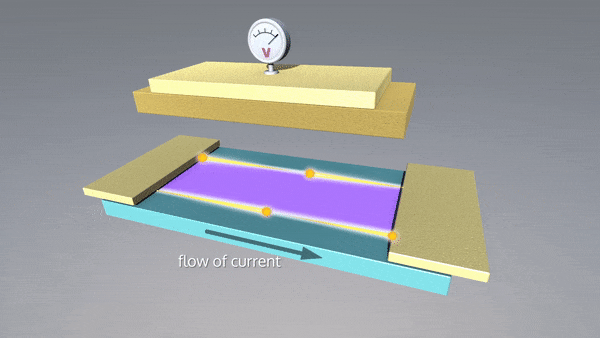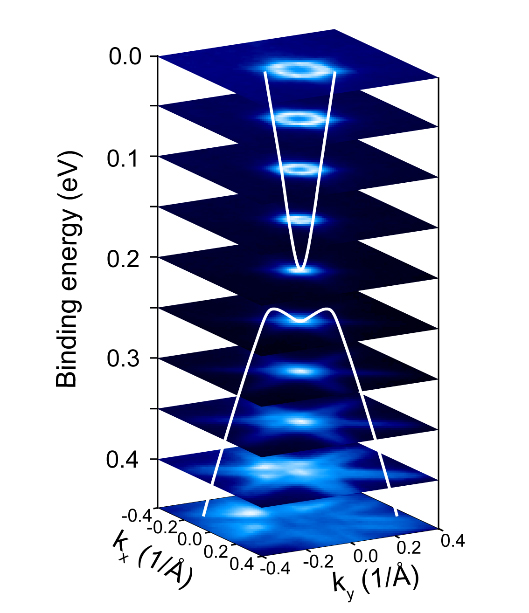SCIENTIFIC ACHIEVEMENT
At the Advanced Light Source (ALS), researchers synthesized a topological insulator between two ferromagnetic layers and found that it is electronically characterized by a large magnetic band gap.
SIGNIFICANCE AND IMPACT
The results open a new path toward lossless charge transport and perfect spin polarization, which could lead to the development of ultralow-energy electronics and spintronics.

Sustainable technological growth
Advances in microelectronics have put enormous computing power at our personal disposal, vastly improving the ways in which we work, play, and live. However, these benefits bear significant energy costs, and scientists are continually searching for ways to increase computing power while reducing power consumption.
Toward that end, a team led by researchers from Monash University in Australia meticulously grew an ultrathin topological insulator, atom by atom, and sandwiched it between two ferromagnetic insulators. Such a heterostructure had been predicted to support a rare phenomenon known as the quantum anomalous Hall (QAH) effect, in which spin-polarized electrons (i.e., electrons with a single spin direction) travel along the edges of the topological insulator with near-zero resistance. A successfully fabricated QAH insulator would provide a promising avenue toward viable ultralow-energy electronic and spintronic devices.
The secret sauce: magnetic order
To turn a topological insulator (which includes both spin-up and spin-down edge currents) into a QAH insulator (with edge currents of just one type of spin), it’s necessary to induce magnetic order in the material. While it’s possible to do this by adding dilute amounts of magnetic dopants, it can be a challenging process that actually results in magnetic disorder, which greatly suppresses the temperature at which the QAH effect can be observed.
A better strategy is to place ferromagnetic layers on the top and bottom of the topological insulator, inducing magnetic order via proximity effects. The challenge in this case is to overcome the undesired influence of the abrupt interface potential arising from a lattice mismatch between the materials.
Matching lattices
The researchers needed to find a ferromagnetic material with chemical and structural properties similar to that of the topological insulator. This way, instead of an abrupt interface potential, there is a magnetic extension of the topological surface state into the magnetic layer.
One promising architecture involves a sandwich structure with two layers of the ferromagnetic insulator, MnBi2Te4 (MBT), on either side of the ultrathin topological insulator, Bi2Te3 (BT). This MBT/BT/MBT structure, with a lattice mismatch of only 1%, had been predicted to yield a robust QAH insulator phase with a large band gap—an observable indicator of the QAH effect.
Synthesis and characterization

At ALS Beamline 10.0.1, the researchers synthesized the MBT/BT/MBT heterostructure via molecular beam epitaxy. The samples were then immediately transferred to an interconnected chamber to probe the system’s electronic structure using angle-resolved photoelectron spectroscopy (ARPES). The data revealed features consistent with the predicted QAH effect: massive Dirac fermions (cone-shaped bands) with hexagonally warped (snowflake-like) cross sections, and a large band gap of 75 meV.
The magnetic origin of the band gap was confirmed via magnetization measurements and temperature-dependent ARPES measurements, which showed that it vanished above the system’s Curie temperature (about 20 K). The results were also in excellent agreement with first-principles density functional theory calculations. Overall, the work indicates that this quantum-material sandwich is a good candidate for supporting the QAH effect at elevated temperatures and, in general, provides insights into magnetic proximity effects in topological insulators, which will help push lossless transport in topological insulators toward higher temperatures.
Contact: Mark Edmonds
Researchers: Q. Li, C.X. Trang, N. Medhekar, and M.T. Edmonds (Monash University, Australia); W. Wu (Singapore University of Technology and Design and Nanyang Technological University, Singapore): J. Hwang and S.-K. Mo (ALS); D. Cortie (Australian Nuclear Science and Technology Organization and University of Wollongon, Australia); and S.A. Yang (Singapore University of Technology and Design).
Funding: Australian Research Council, Australia’s Nuclear Science and Technology Organisation, and Singapore Ministry of Education. Operation of the ALS is supported by the U.S. Department of Energy, Office of Science, Basic Energy Sciences program.
Publication: Q. Li, C.X. Trang, W. Wu, J. Hwang, D. Cortie, N. Medhekar, S.-K. Mo, S.A. Yang, and M.T. Edmonds, “Large Magnetic Gap in a Designer Ferromagnet–Topological Insulator–Ferromagnet Heterostructure,” Adv. Mater. 34, 2107520 (2022), doi:10.1002/adma.202107520.
Adapted from the FLEET press release, “Making a ‘Sandwich’ Out of Magnets and Topological Insulators, Potential for Lossless Electronics.”
ALS SCIENCE HIGHLIGHT #465